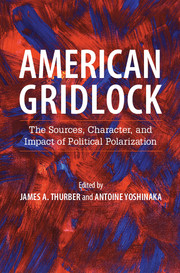Book contents
- Frontmatter
- Dedication
- Contents
- List of contributors
- Foreword
- Acknowledgments
- Introduction
- PART I POLARIZATION AMONG VOTERS AND ACTIVISTS
- PART II POLARIZATION IN NATIONAL INSTITUTIONS
- PART III POLARIZATION IN THE STATES
- PART IV POLARIZATION IN THE MEDIA
- PART V IMPLICATIONS AND CONCLUSIONS
- Index
- References
Introduction
Published online by Cambridge University Press: 05 November 2015
- Frontmatter
- Dedication
- Contents
- List of contributors
- Foreword
- Acknowledgments
- Introduction
- PART I POLARIZATION AMONG VOTERS AND ACTIVISTS
- PART II POLARIZATION IN NATIONAL INSTITUTIONS
- PART III POLARIZATION IN THE STATES
- PART IV POLARIZATION IN THE MEDIA
- PART V IMPLICATIONS AND CONCLUSIONS
- Index
- References
Summary
Partisan polarization among the public, activists, and elected officials characterizes American politics in the twenty-first century, and it is often seen as the major source of our governing problems (Schaffner 2011, Persily 2015). Republicans and Democrats are further apart ideologically than at any point in recent history, expressing highly negative views of the opposing party (Doherty 2014). The deleterious impact of partisan polarization cannot be exaggerated. It discourages compromise, produces gridlock, fosters mistrust, and ultimately hinders the functioning of governmental institutions. Lawmaking, representing, overseeing, executing laws, and adjudicating legal and constitutional disputes requires that individuals who might otherwise disagree come together and serve interests that go beyond their own. Failure to compromise results in gridlock, dysfunction, and partisan warfare. To paraphrase former House Speaker Sam Rayburn, we are not going along, let alone getting along!
It was not always thus. In fact, during much of the twentieth century, our national parties did not exhibit this sort of intense partisan polarization that we have seen emerge over the last generation or so. To understand how we got to where we are today, we must account for the rapid partisan change that the U.S. South has witnessed over the latter half of the twentieth century. Long gone are the days of the conservative southern Democrats (Dixiecrats) holding a more liberal northern caucus in check. Largely as a response to federal intervention in the civil rights arena, conservative southern Democratic voters started to migrate toward the GOP in the mid-1960s. Todaye's southern conservatives are well ensconced within the Republican Party. Southern Democrats in 2014 are largely liberal and nonwhite. The South has realigned politically. A similar, if not somewhat less acute, change occurred in reverse in other parts of the country such as the northeastern and the far west of the United States. With large swaths of the country realigning into one or the other party, each partye's coalition has become much more homogeneous ideologically and in terms of policy preferences. To be liberal in 2014 is to be a Democrat; the same goes for conservatives and Republicans. Battles over the scope and size of the federal government have produced a wide policy schism between parties.
WHY WRITE THIS BOOK?
Although it is true that the literature on gridlock and polarization is extensive, it is also the case that it is quite disparate.
Information
- Type
- Chapter
- Information
- American GridlockThe Sources, Character, and Impact of Political Polarization, pp. 1 - 16Publisher: Cambridge University PressPrint publication year: 2015
References
Accessibility standard: Unknown
Why this information is here
This section outlines the accessibility features of this content - including support for screen readers, full keyboard navigation and high-contrast display options. This may not be relevant for you.Accessibility Information
- 1
- Cited by
